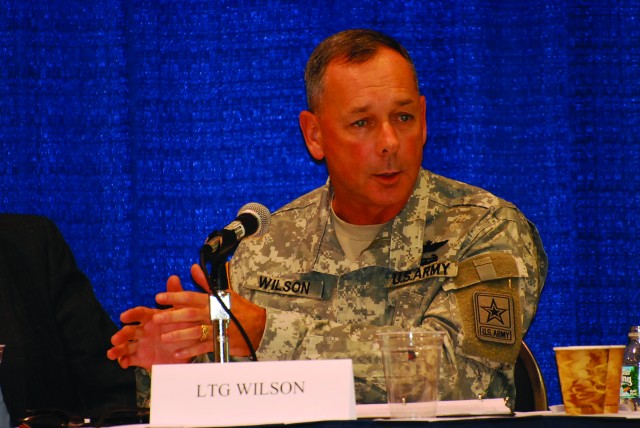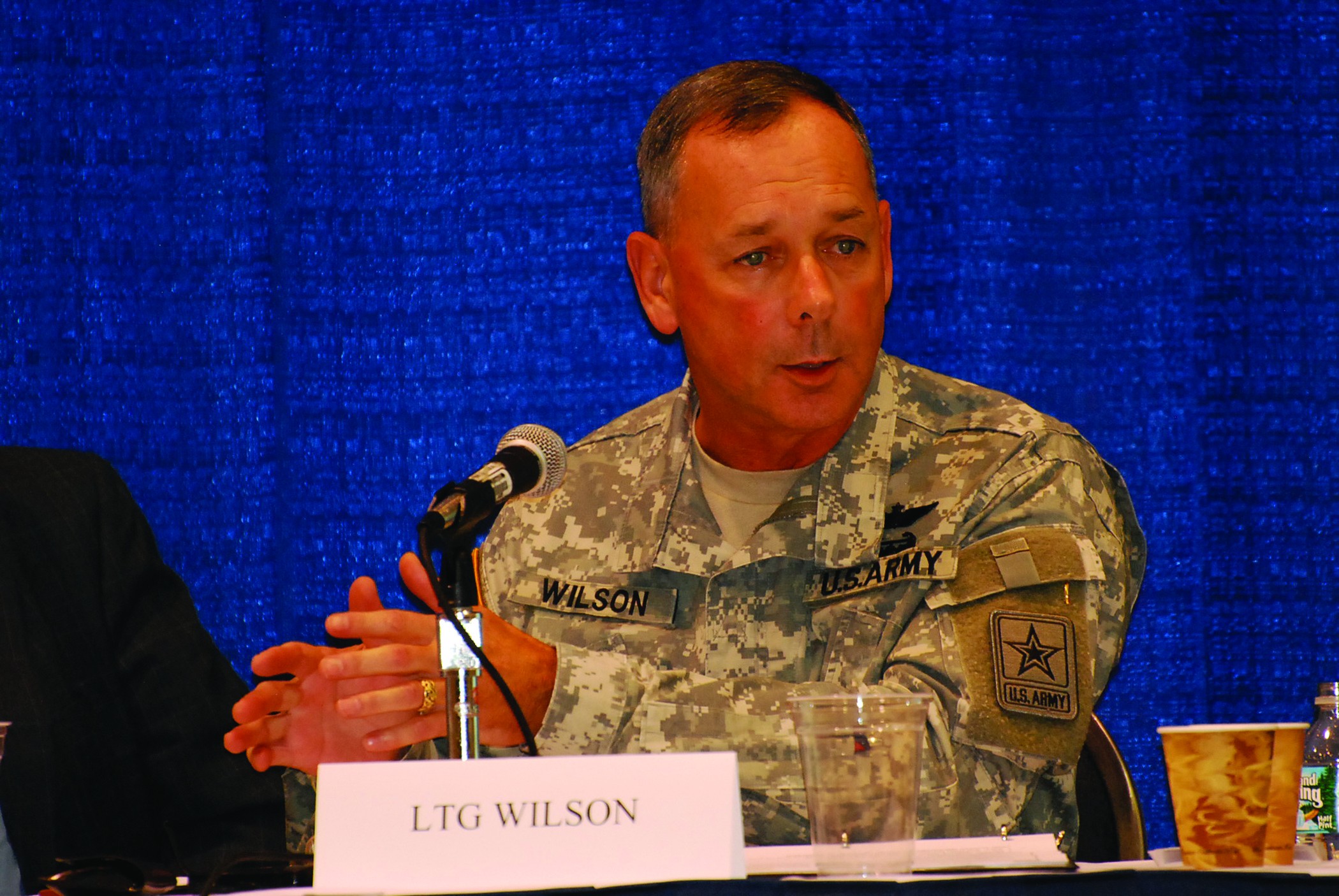
PENTAGON (Washington D.C.) - Institutional Adaptation challenges the Army to be as creative and collaborative as our Soldiers are brave on the battlefield and their Families are resilient and supportive back home.
The purpose of Institutional Adaptation, an essential component of the Army's overall transformation effort, is to put the Army back in balance as it aligns functions, processes, and working relationships of the Generating Force and the Operational Force in order to most effectively and efficiently generate trained and ready forces within available resources and preserve the All Volunteer Force.
Achieving the balance between deployment readiness with a respect for the human dimension of service to the Army demands thoughtful and imaginative solutions as well as a lot of teamwork and good ideas from people committed to making a difference. To assure we are sending the right people and equipment to the right place on time, yet keep the All Volunteer Force at its high professional standard with full Family backing, the Army is adapting the way it does business by focusing effort through four Core Enterprises: Readiness, Material Human Capital and Services and Infrastructure.
Under Institutional Adaptation, the Services and Infrastructure Core Enterprise (SICE) supports training and mobilization of Active Component and Reserve Component Forces, while providing a full range of Installation and Family Support activities before, during and after the Soldiers' absence. Defining the least tangible, but no less important forward-looking requirements of the SICE requires a special leader with the character and temperament to bring together the collective energy and wisdom of 17 Core Enterprise members in a spirit of common purpose.
Managing SICE, ensuring Soldiers and Families are provided a quality of life that is commensurate with their service, and managing and supporting the Army's 157 installations, is the responsibility of the assistant chief of staff for Installation Management and the commanding general of the Installation Management Command, Lt. Gen. Robert Wilson. He is also that special leader who drives the enterprise members toward the common purpose.
Wilson is a respected cavalryman, having experienced first-hand the highs and lows of support to Soldiers and Families from the Vietnam-era Army to the present, perhaps no Soldier is better prepared and postured at the right place at the right time to synchronize the services and infrastructure elements of Institutional Adaptation. Although he will retire in November after 37 years of service to his country, he says there is work still to be done in regard to improving the quality of life for those who will continue to serve.
Wilson has witnessed the past eight years of persistent conflict that has required the Army to operate on a rotational readiness cycle. He has seen how the current institutional systems are not aligned to support it.
Wilson recognizes that Institutional Adaptation improves the support Army Force Generation (ARFORGEN), and reduces the turbulence for Soldiers, Families, and civilians.
"It has the greatest potential for optimization of Army resources through integration of supporting enterprises," Wilson said.
He realizes it is imperative to collaborate, synchronize, and integrate through the functional alignment of Core Enterprises, because it delivers the right services in the right places at the right time and at the least cost. He knows the resourcing and requirements must be refined.
Knowing and doing can be two different things, but for Wilson and the men and women working to improve all the Enterprises, there are tangible results in their efforts via their Core Enterprise to adapt the Army's Institutions (its Generating Force) to support the Operational Force.
General Wilson is a true change agent for the Army as it transforms operations to a business enterprise approach through Institutional Adaptation. However, Wilson takes no credit for the successes; rather he attributes all achievements to a process characterized by open collaboration among such senior counterparts as his co-chair on the SICE Board, Jerry Hansen, assistant secretary of the Army for Installations and Environment, along with general officers from seven aligned Core Enterprise organizations to include Lt. Gen. Eric Schoomaker, surgeon general and commander, U.S. Army Medical Command, and Lt. Gen. David Valcourt, deputy commanding general and chief of staff, Training and Doctrine Command.
In creating a cooperative environment at both the upper tier of the process at the SICE Board and the subordinate level General Officer Steering Committee, the working group level action officers have been inspired and empowered to reach out across all the enterprises effectively transcending the Army's traditional horizontal approach to the decision-making.
Wilson said that "together" they have been maintaining a constant battle rhythm through eight years of war and uncertainty. This battle rhythm has enabled us to maintain an All-Volunteer Force and meet the expectations we set for our Soldiers, Civilians and Families, to include, "manning, equipping, installation readiness, and quality of life," Wilson said.
Early in the SICE process its members discovered that true power of collaboration as an enterprise. In analyzing ways to improve SICE support to the ARFORGEN, the members determined that the Human Dimension of ARFORGEN had not been analyzed from a Soldier and Family support perspective. This finding led to a co-authored AUSA Green Book article prepared by Wilson, Schoomaker, and Chaplain (Maj. Gen.) Douglas Carver, the Army's chief of chaplains.
The SICE has since explored ways to improve other Soldier and Family Support systems with measured success, to include the Army's approach to the Army Substance Abuse Program as well as a comprehensive review and definition of all Army Family programs.
The Army's reputation for taking care of its people contributed to recruiting the All-Volunteer Force. We reinforce the Army Family Covenant daily through quality support and services. This in turn contributes to truly inspiring re-enlistment rates for our Soldiers and the Families that support them.
Wilson believes that by taking an enterprise approach to the way IMCOM does business has already yielded significant savings and cost avoidance for the command and the Army. This approach has been increased to extend the reach of services and support to the Army Reserve, Army National Guard, and geographically dispersed Soldiers. He said SICE has formed strategic partnerships with DoD and with industry, integrating organizations which provide operational support across the Army. More Army installations have been added to the Services and Infrastructure Enterprise, to include extending the reach to expeditionary garrisons. According to the general, the Core Enterprise's organizations have a common, enterprise-level commitment to the outcomes they are striving to achieve.
"To improve delivery of operational support to ARFORGEN, we must look over the horizon, collaborate and innovate with industry, and invest in high payoff opportunities," Wilson said. He believes there must be a continual cultural change necessary for improving the enterprise approach in delivery of services and operational support. The development of new, innovative strategic partnerships, both inside and outside of government is paramount to capitalizing on the technological revolution, particularly in communications network and intelligence, energy, sustainability, and construction activities.
The decision to transition to a CONUS-based Expeditionary Army, and a reduction of U.S. presence overseas coincided with a concerted effort by the Army to improve services to allow commanders to focus on combat readiness while at the same time improving the quality of life for Soldiers and Families.
According to Wilson, this had a great impact on how Soldiers train, deploy, and live in and around installations and how they connected to Army services and programs. The quantity, quality and expectations of installation support and services have increased because of the needs and requirements of an Army at war.
Through the efforts of the Services and Infrastructure Core Enterprise, the directors of Information Management (DOIM) and directors of Logistics (DOL) are realigning to an enterprise management structure. The DOIM realignment aligns all the network organizations under one organization to not only garner efficiencies but to enhance security. The DOL realignment aligns garrison DOL services with the appropriate Core Enterprise; for example, director of Services with SICE and director of Materiel with Materiel Core Enterprise. By taking a matrix approach, the changes are seamless to the customer and the gtarrison commanders will still be the single point of contact.
Progress has also been noted with the work being accomplished with the Materiel Core Enterprise to realign Special Installations. On Aug. 4, as a follow on to a command visit to Fort Detrick, Md., the ACSIM staff is developing an Interagency Installation Support Agreement to meet the requirements of the National Interagency Biological Defense Campus, a five, cabinet-level activity, at the fort.
The SICE is transforming services and infrastructure contract management and training. The intent of the contract management program is to increase the garrison commander's awareness of all the contracts, trends, personnel, and contract performance. Implementation guidance for contract management in IMCOM was published in June; initial garrison quarterly reviews were conducted in July; region quarterly reviews were accomplished mid-August; and an IMCOM-level quarterly review will be completed in September.
In June, the Core Enterprise created an SES-led Metrics Task Force that will link the AEB Strategy Map to the SICE Strategy Map and Installation Management Business Model.
"This has the opportunity to cascade to stakeholder commands aligned with SICE enabling a true top-down, bottom-up alignment of strategic activities," Wilson said.
Wilson appreciates all that has been accomplished and looks forward to tackling the challenges with his partners from multiple organizations with a wide range and variety of missions, such as the U.S. Army Medical Command, U.S. Army Intelligence and Security Command, Network Enterprise Technology Command, and U.S. Army Corps of Engineers, among others who participate in SICE. He believes that as the SICE continues to evolve, the members of the Core Enterprise will continue to discover ways and means to improve support to the Army.
Wilson is committed to tapping the potential of what can be achieved as the principles of performance management to every aspect of service and infrastructure are applied. He says the men and women are committed to their objective to eliminate inefficient applications of resources. He said they are dedicated to exploring future programs in the SICE that will exploit the advantages of an Army-wide approach.
"I am proud of what has been done; We have great Soldiers and civilians! Our people are passionate, devoted, and dedicated to the Army's covenant with Soldiers, civilians, and Families, to provide a quality of life, commensurate with their quality of service," said Wilson.
He believes his most significant contribution in his career is heading the Installation Management Command, a structure and a command which allows for the management of Army installations across the spectrum of the Army, opposed to the former mode of operation when individual commands were responsible for their own management resulting in different levels of readiness, resources, and expectations.
"Senior commanders don't need to worry about the care of their installations and instead can focus on war fighting and operational issues," he said.
He is also proud for his role of the transformation of his organization with the move to San Antonio, Texas, and for the change in focus on Soldiers, civilians, and Families.
Adlai E. Stevenson (former American statesman) said, "Patriotism is not short, frenzied outbursts of emotion... it is tranquil and steady dedication of a lifetime." As a true change agent for the Army and as a true patriot, Wilson has served as a role model, and his actions are key for the culture change, the mind set change, needed for the Army to run as an enterprise. Wilson's efforts, contributions, and successes will certainly help lead the way in building smarter for a stronger Army.

Social Sharing